|
Page < 1 2 3 4 5 6 7 8 9 10 11 12 13 14 15 16 17 18 19 20 21 22 23 24 25 >
Show
in alphabetical order
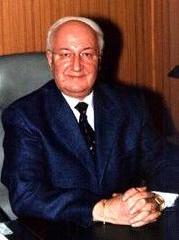 341.
Alexander
M. Kadakin (
? ) Former Russian
Ambassador in India. In his column Passage
to India: The Coexistence of Multiple Realities,
he has written: 341.
Alexander
M. Kadakin (
? ) Former Russian
Ambassador in India. In his column Passage
to India: The Coexistence of Multiple Realities,
he has written:
"How
more profound is India 's traditional world, where each stone is a hierophant, a
sign of the presence of the sacred in our world. Every sunrise here becomes a
cosmogenic drama, every woman an embodiment of the tantric principle of Shakti.
Behind the exterior forms specific only of India hides the sublime universal
paradigm of the traditional conscience totally opposite to the modernistic one,
also far more vibrant and wholesome. The craving of human soul for sacral
archetypes is unquenchable, and archetypes are easily juxtaposed with new age
constructs. The sacral and the profane coexist. "
It took me time to realize that my
India is similar to the human body with its seats of power and intellect and
various indriyas. At times the body is guided by reason, and at other times by
mere emotion. It might feel rigid in the morning, elastic by day time,
overexcited by evening, and frustrated by night. It fights its ups and downs,
tides and ebbs, low and high spirits. It looks different if observed from
various angles: familiar yet mysterious, gorgeous yet shabby, pure yet impure. I
have visited many other countries, but I reserve this complex metaphor of the
body for India .
India seems to be specially
designed by the Vidhata to defy all prognoses and theories. My heart remains
here but all my Indias will travel back along with me, needing no extra space in
the plane. And new ones will appear when I return.
Once I heard you weeping.../ Timidly.
The scent of salty sands/ Was strumming
the sitar./
Your laments made me love and treasure you,/ I India./
And when you
were leaving,/ A soft sirocco burned my lips./ It was your kiss, I India!
(source:
Passage
to India: The Coexistence of Multiple Realities
- timesofindia.com).
http://www.india.mid.ru/india/2e.html
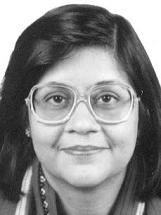 342.
Sandhya Jain ( ? ) author of Adi
Deo Arya Devata. A Panoramic View of Tribal-Hindu Cultural Interface
and
Evangelical Intrusions
as well as eminent columnist in the
mainstream English Media of India, she has written eloquently about
Hinduism: 342.
Sandhya Jain ( ? ) author of Adi
Deo Arya Devata. A Panoramic View of Tribal-Hindu Cultural Interface
and
Evangelical Intrusions
as well as eminent columnist in the
mainstream English Media of India, she has written eloquently about
Hinduism:
"India has existed for
several millennia; it is rooted in history and enshrined and encompassed by a
civilisational ethos based on the attainment of Consciousness (self-realisation).
India's ancient religion, Hinduism, is not a codified creed in the manner of
other world religions. Properly known as the Sanatan Dharma or the Eternal
Tradition, it is simultaneously a religion and a living civilisation or way of
life, and is inspired by the ideal of universal welfare of all beings, both
human and other creatures. Dharma is natural (cosmic) law. As Hinduism, it takes
on a formal structure, creed and ritual; yet it is never the captive of
absolutism.
"The sanatan dharma recognises even the atheist as morally valid, and
does not deny him space in the religious-spiritual spectrum. This is because
sanatan dharma is all-embracing: it is righteousness, duty, and the eternal law
that is not fixed (in time or space) but eternally renews itself in response to
changing times and provides for as many paths to salvation as there are
individual souls who seek it."
"Dharma demands that all
faiths be treated with respect and courtesy, as they are all attempts to attain
Godhead. Its quintessential argument is that each soul must chart its own
evolutionary course, and that it is not given to any human agency to arbitrate a
final truth for all mankind. Hindus do believe that the Vedas are the revealed
truth that was heard by the Vedic rishis (Sruti). But that is no reason that
they should be imposed upon the world by human regents who claim to be sole
prophets of the only true revelation. This is the reason why, despite the belief
in One Supreme Being, non-monotheism has been the hallmark of all Indic
religions. Our polity and innate secularism has flowed naturally from these
values; it is not for nothing that Aristotle observed that the Hindus were the
only people to have successfully made dharma the basis of their public life
(Politics)."
"Being
a living civilization, Hinduism is by definition multi-dimensional,
multi-layered. It is inherently distrustful of the one-dimensional approach
towards religion, and does not perceive other faiths as alien, threatening or
unacceptable."
"Hinduism is a subtle,
complex, multi-dimensional spiritual cosmos. Although it spawned a great and
powerful religion with profound philosophies and daring intellectual constructs,
it never ceased to be a 'way of life.' It never wholly identified with the
religious forms it gave birth to (Shaivism, Vaishnavism, et al), nor was it
subsumed by them. This is how it remains a living civilization: the individual
seeker is accommodated theoretically and actually. Even today a seeker may
reject the world of man and the world of formal religion, and pursue a solitary
salvation on the banks of the Ganga or in the Himalayan mists. None may
chastise him for deviance (for there is none), nor catechize him about the path
to take (for there are as many paths as there are seekers). "
(source: The
manacles of monotheism - By Sandhya Jain and The
Indic tradition is catholic - By Sandhya Jain). For more thoughts
by Sandhya Jain, refer to chapter on Articles).
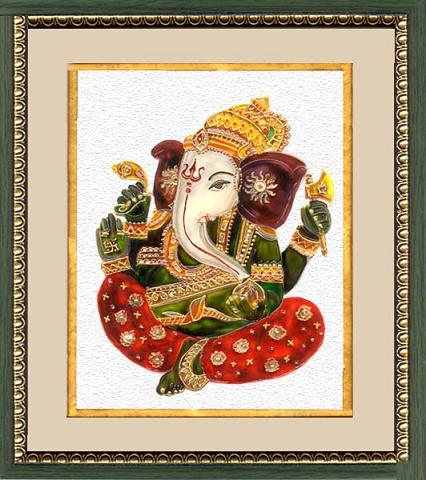
Exquisite image of Lord Ganesha
"Hinduism is a subtle,
complex, multi-dimensional spiritual cosmos. Although it spawned a great and
powerful religion with profound philosophies and daring intellectual constructs,
it never ceased to be a 'way of life.'
(image
source: http://www.123ganeshchaturthi.dgreetings.com/).
***
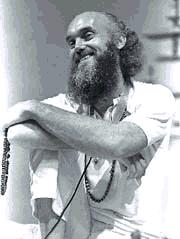 343.
Ram Dass
(1931- ) was born Richard
Alpert, the bright and personable scion
of a wealthy, influential Jewish family.
His father, George Alpert, a prominent Boston lawyer, helped found
Brandeis University and was president of the New York, New Haven & Hartford
Railroad. Alpert
taught at Harvard in the '60s, joining his colleague Timothy Leary in
"consciousness-raising" experiments. 343.
Ram Dass
(1931- ) was born Richard
Alpert, the bright and personable scion
of a wealthy, influential Jewish family.
His father, George Alpert, a prominent Boston lawyer, helped found
Brandeis University and was president of the New York, New Haven & Hartford
Railroad. Alpert
taught at Harvard in the '60s, joining his colleague Timothy Leary in
"consciousness-raising" experiments.
 Alpert
has been studying the nature of consciousness for more than 50
years, and began his studies with psychology, specializing in human motivation
and personality development. While at Harvard in 1961,
Alpert's explorations of human consciousness led him to collaborate with Timothy
Leary, Ralph Metzner, Aldous Huxley, Allen Ginsberg. Alpert
has been studying the nature of consciousness for more than 50
years, and began his studies with psychology, specializing in human motivation
and personality development. While at Harvard in 1961,
Alpert's explorations of human consciousness led him to collaborate with Timothy
Leary, Ralph Metzner, Aldous Huxley, Allen Ginsberg.
Unsatisfied
by that research
Alpert
then
traveled to India where he met a man, Neem Karoli
Baba, who would become his Hindu guru. Alpert
stayed on to study Hinduism with this master, was renamed Ram Dass, and
subsequently came back to the States to spread word of new techniques for
spiritual practice based on yoga and transcendental meditation using a repeated
mantra, such as "Om.
Since
1968, Ram Dass has pursued a variety of spiritual methods and practices from
various ancient wisdom traditions, including devotional yoga focused on the
Hindu spiritual figure Hanuman. In
1974, Ram Dass created the Hanuman
Foundation,
which developed the Prison Ashram Project, designed to help prison inmates grow
spiritually during their incarceration, and the Dying Project, conceived as a
spiritual support structure for conscious and dying. He helped usher in the
New Age movement.
Now
in his seventies, Ram Dass remains best-known for his 1971 classic bestseller Be
Here Now, a
book which sparked a generation’s quest for expanded consciousness and
meaningful spirituality. Ram Dass is a co-founder and advisory board member of
the Seva Foundation, an international service organization.
"one
of his messages is that we are both human and divine and that we must hold both
simultaneously."
(source: pbs.org
and slate.com).
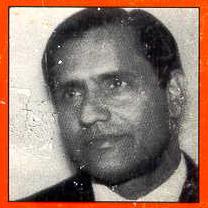 344.
T C Galav
( ? ) author of the book Philosophy
of Hinduism writes: 344.
T C Galav
( ? ) author of the book Philosophy
of Hinduism writes:
"Hindus have given the world a Krishna, a
Buddha, a Gandhi, and hundreds of equally great saints, seers and scholars from
Valmiki and Ved Vyasa to Samkra, Tulsidasa and Vivekananda, and with them a most
logical, scientific and secular philosophy of religion and free worship of God
or free contemplation of the supernatural - something different from dogmas and
creeds based on miracles, mysteries, and irrational stories."
"Hinduism is freedom,
especially the freedom in thinking about God."
"Unlike other religions, Hinduism has no founder.
It does not depend for its authority on the personality of any man - a messiah,
a savior, a prophet, or a guru. Its authority is eternal Truth which has
revealed itself through the minds of great rishis who perfected themselves by
long penances and are said to have heard in their hearts eternal truths as Sruti.
Thus, it has become a cumulative record of metaphysical experimentation."
Rig Veda is the Veda par excellence, the real
Veda that traces the earliest growth of religious ideas in India. It is the
earliest book of the Hindus and, indeed of the whole world. It
is in poetical form, has one thousand twenty eight poems or hymns called Samhita.
It is so much full of thought that at this early period in history no poet in
any other nation could have conceived them. "
(source: Philosophy
of Hinduism - An Introduction By T. C. Galav
Universal Science-Religion. ISBN: 0964237709 p 1 - 38. Note:
This book served as an inspiration for the creation of
this website).
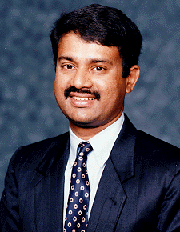 345.
Rajeev Srinivasan ( ?
) works in software sales and is a marketing professional, and writes commentary for Rediff.com. He graduated from IIT Madras and the Stanford Business School. 345.
Rajeev Srinivasan ( ?
) works in software sales and is a marketing professional, and writes commentary for Rediff.com. He graduated from IIT Madras and the Stanford Business School.
He writes in his column:
"Hinduism is the most apolitical of religions,
with an extremely clear separation of church and state. This has always been the
case historically."
(source: Tools
of the 'secularist' arsenal - By Rajeev Srinivasan - rediff.com).
Ancient Indians did recognize the importance of
their rivers as literally the lifeblood of the nation. Hence the great honour
and respect given to them in Hindu scriptures. See, for example, the sloka:
Gange cha! Yamune chiava! Godavari! Sarasvati!
Narmade! Sindhu! Kaveri! Jale asmin sannidhim kuru!
In this water, I invoke the presence of holy
waters from The rivers Ganga, Yamuna, Godavari, Sarasvati, Narmada, Sindhu and
Cauvery!
The divinity attributed to the sacred rivers such
as the Sarasvati, the Ganga, the Cauveri, and the Narmada has perhaps helped us
manage and preserve them. The Rg Veda speaks often about the mighty river
Sarasvati, as broad as the ocean. In the story of Indra's slaying of the
water-demon Vrtra, we see the damming of the river and its subsequent release.
Pilgrims even today undertake the arduous trek to Gaumukh, the origin of the
Ganga/Bhagirathi, even though the glacier that gives rise to the river has
receded eighteen kilometers away from the original temple to Ganga built
millennia ago at the then source, Gangotri.
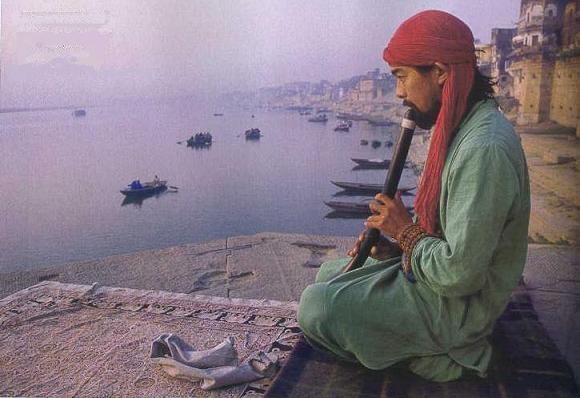
Ancient Indians did recognize the importance of
their rivers as literally the lifeblood of the nation. Hence the great honour
and respect given to them in Hindu scriptures.
A Flutist sadhu plays
reverentially along the ghats of Varanasi, one of the world's most sacred
centers of Hinduism.
(image source: National Geographic Traveler magazine -
Nov/Dec 2004).
***
The Sarasvati, along whose banks the bulk of the
settlements of the Indus-Sarasvati (Harappan) civilisation can be found, dried
up circa 2000 BCE, after an earthquake caused its tributaries to be captured by
other rivers, the Sutlej by the Indus, and the Yamuna by the Ganga. The Indus-Sarasvati
civilisation declined precipitously thereafter, and its next flowering was
hundreds of years later, in the Gangetic Plain to the east. The river died, and
so almost did the civilisation; this is a cautionary tale for us. There are
those who still remember the long-lost river. The Gauda Saraswat Brahmins of the
Konkan coast, Sarasvati's children, still recall that immense river, whose
course was eight kilometers wide in parts.
(source: The
River sutra - By Rajeev Srinivasan - rediff.com). He
writes about ancient India's greatest achievement:
"Panini's grammar, dating back
2500 years, and encapsulating the complete structure of Sanskrit in four
thousand context-free rules, is arguably the greatest achievement of a single
human mind in all of history.
The sheer audacity to imagine
capturing the infinity of language in the finitude of a set of rules is simply
breathtaking: it could only have come from ancient India which invented the
ideas of the infinite and the infinitesimal, and the correspondence between the
two. The concept of context-free languages was re-invented only in the 1950s by
computer scientists, since ambiguity is unacceptable to computers.
To take mathematics and
astronomy, Madhava, Nilakantha and Parameswara of the Kerala school invented the
ideas of the calculus and infinite series (including the so-called Taylor
series) circa 1500 CE, and these were most probably transmitted to Europe by
Jesuit missionaries. The so-called Pythagoras theorem was discussed by
Baudhayana about 500 years before Pythagoras. Aryabhata calculated pi to six
decimal places in 499 CE. Saayana appears to have accurately calculated the
speed of light around 1370 CE."
(source: Pax
Indica and a multipolar world - By Rajeev Srinivasan - rediff.com).
For more on Rajeev Srinivasan, refer to chapter on Articles).
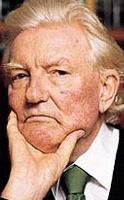 346.
Paul
Johnson
(
? )
eminent
British historian and author of several books including A
History of the American People has observed that to prosper a nation needs
tolerance. He pointed out the economic value of being tolerant. All
societies flourish mightily when tolerance is the norm. And India is a good
example of this. India's tradition, particularly the
Hindu tradition of tolerance, has been exalted by Johnson to make his
point that whenever a society develops tolerance, there is prosperity in the
society. 346.
Paul
Johnson
(
? )
eminent
British historian and author of several books including A
History of the American People has observed that to prosper a nation needs
tolerance. He pointed out the economic value of being tolerant. All
societies flourish mightily when tolerance is the norm. And India is a good
example of this. India's tradition, particularly the
Hindu tradition of tolerance, has been exalted by Johnson to make his
point that whenever a society develops tolerance, there is prosperity in the
society.
He says this about India:
"
It is the nature of the Hindu religion to be tolerant and, in its own
curious way, permissive. Under the socialist regime of Jawaharlal Nehru and his
family successors the state was intolerant, restrictive and grotesquely
bureaucratic. That has largely changed (though much bureaucracy remains), and
the natural tolerance of the Hindu mind-set has
replaced quasi-Marxist rigidity."
(source: Forbes.com).
In
what appeared to be a thumbs-up to Hindu nationalism espoused by the BJP
government,
Johnson also took a swipe at the country’s Congress
legacy, arguing that “under the socialist regime of Jawaharlal Nehru and his
family successors the state was intolerant, restrictive and grotesquely
bureaucratic. “That has largely changed (though much bureaucracy
remains), he wrote, and the “natural tolerance of the
Hindu mind-set has replaced quasi-Marxist rigidity.”
(source: Boontimes
for Hindu rate of growth
- By Chidanand Rajghatta -economictimes.com and http://www.indianewengland.com/news/702058.html?mkey=1060861).
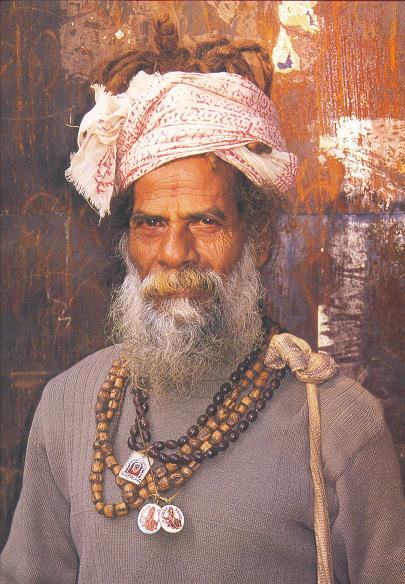
"It is the nature of the Hindu religion to be tolerant and
the natural tolerance of the Hindu mind-set has
replaced quasi-Marxist rigidity."
(image source: India Unveiled - By Robert Arnett
p. 65).
***
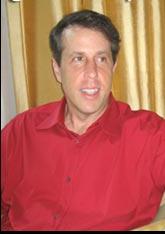 347.
Andrew
Krieger ( ? ) President
and CEO of NorthBridge Capital Management. A
BA in Philosophy (Magna Cum Laude, Phi Beta Kappa), an MBA in Finance -- and
prior to that, an MA in South Asian Studies, most notably Sanskrit.
He has
studied Sanskrit and Indian philosophy. 347.
Andrew
Krieger ( ? ) President
and CEO of NorthBridge Capital Management. A
BA in Philosophy (Magna Cum Laude, Phi Beta Kappa), an MBA in Finance -- and
prior to that, an MA in South Asian Studies, most notably Sanskrit.
He has
studied Sanskrit and Indian philosophy.
He
has visited India more than 20 times, studying yoga,
traveling, introducing his family to "my
love affair with an amazing civilization."
Krieger
said he thought he had "ended up in the wrong body," meaning that he
is really an Indian in his heart. I have heard this from my wife. India does
this to some people.
"I got turned on to
Vedanta when I was about 11 years old,"
The
India I know has tremendous genetic capabilities; but 700 years of foreign rule
has put a dampener on it. I still believe that it is
the greatest civilisation ever on this planet, and those strong
genetic factors are bound to re-emerge -- if you look at what is happening to
the country, the way geniuses are emerging to lead it in every field, it is
already happening in a sense, people, leaders with vision, are emerging.
When I talk of genetics,
look, sports has been part of India's heritage for 5,000 years or more. Archery,
for instance; wrestling; swimming, all these used to be part of Indian sporting
tradition.
(source: India
has tremendous genetic capabilities - rediff.com and IMG
to Open Sports School in India - nytimes.com).
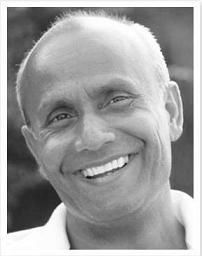 348.
Sri Chinmoy (1931
- )
born Chinmoy Kumar Ghose in the small village of Shakpura in East Bengal. In
1944, after both his parents had died, 12 year-old Chinmoy entered the Sri
Aurobindo Ashram, a spiritual community near Pondicherry in South India. Here he
spent the next 20 years in spiritual practice - including long hours of
meditation, practising athletics, writing poetry, essays and spiritual songs. In
his early teens, Chinmoy had many profound inner experiences, and in subsequent
years achieved very advanced states of meditation. In 1964, he moved to New York
City to share his inner wealth with sincere seekers in the West. 348.
Sri Chinmoy (1931
- )
born Chinmoy Kumar Ghose in the small village of Shakpura in East Bengal. In
1944, after both his parents had died, 12 year-old Chinmoy entered the Sri
Aurobindo Ashram, a spiritual community near Pondicherry in South India. Here he
spent the next 20 years in spiritual practice - including long hours of
meditation, practising athletics, writing poetry, essays and spiritual songs. In
his early teens, Chinmoy had many profound inner experiences, and in subsequent
years achieved very advanced states of meditation. In 1964, he moved to New York
City to share his inner wealth with sincere seekers in the West.
He has written:
"Mother India is an aspiring tree. This
aspiring tree has the Vedas as its only roots. The root is Truth, the tree is
Truth, the experience of the tree is Truth, the realization of the tree is
Truth, the realization of the tree is Truth, the revelation of the tree is
Truth, the manifestation of the tree is Truth. The
Vedic seers saw the Truth with their souls, in their Heavenly visions and in
their earthly actions. Satyam eva jayate nanrtam (Mundakopanisad 3.1.6) - Truth
alone triumphs, not falsehood.
The Vedas have the eternal wisdom. It is for us.
The Vedas are more than willing to illumine us if we dare to listen to their
message. Srnvantu visce amrtasya putrah (Rig Veda X 13.3) Hearken, ye sons of
Immortality. The Vedas are divinely practical value. They house the earliest
poetry and prose literature of the searching, striving and aspiring human soul. He
who thinks that the Vedic poetry is primitive and the Vedic literature
insignificant is unmistakably wanting in such sublime and enduring wisdom to the
world at large?
The body of the Vedic poetry is simplicity
The vital of the Vedic poetry is sincerity.
The mind of the Vedic poetry is clarity.
The heart of the Vedic poetry is purity.
The soul of the Vedic poetry is luminosity.
The Vedic seers accepted the
laws of others not only with their hearts' frankness but also with their souls'
oneness. The saw the One in the many and the many in the One. To them, the
Absolute was not their sole monopoly.
(source: Commentaries on
The Vedas, The Upanishads, and The Bhagavad Gita - By Shri Chinmoy p.
1 - 12).
 349.
Pierre
Teilhard de Chardin
(1881 - 1955)
was a visionary French Jesuit, paleontologist, biologist, and
philosopher. Author the book Le Phenomene Humain,
or The
Human Phenomenon. Teilhard’s evolutionism earned him the
distrust of his religious superiors, while his religious mysticism made
scientific circles suspicious. 349.
Pierre
Teilhard de Chardin
(1881 - 1955)
was a visionary French Jesuit, paleontologist, biologist, and
philosopher. Author the book Le Phenomene Humain,
or The
Human Phenomenon. Teilhard’s evolutionism earned him the
distrust of his religious superiors, while his religious mysticism made
scientific circles suspicious.
A
prominent 20th century scientific Christian theologian, studied Ramanuja’s
Vedanta, and then equated Saguna Brahman with “the body of Christ.” However,
he was persecuted by the Church, and lived in Asia in exile, while writing many
of his works.
(source: Indic
Challenges to the Discipline of Science and Religion - By Rajiv Malhotra ).
Teilhard
de Chardin's extensive study and commentary on Vedanta during his trip to India,
especially Ramanuja's works, are suppressed by his modern
followers, even though
Teilhard used these ideas to develop what is now 'liberal Christianity'. Mary Baker Eddy, founder of Christian Science quoted Indic thought in the early
editions of her books, but these references later got removed as Theosophy and
she became competitors - one deploying Indic ideas openly in a perennial way and
the other within strictly branded Christianity.
(source:
The
Ethics of Proselytizing
- By Rajiv Malhotra -
Hindu Vivek Kendra).
Towards
a New Mysticism, Teilhard de Chardin and Eastern Religions - by
Ursula
King, and in that book
King describes how Teilhard went to India and read Vedanta, and how he commented
on Ramanuja's interpretation, and remarked that his own ideas were similar. Then
he came up with the idea that the cosmos was the body of Christ, which is
comparable to saguna Brahman notion.
(source:
Infinity
Foundation and Indic traditions in Academic System - By Pankaj Jain).
Because
Teilhard's ideas are to a great extent plagiarisms from Vedanta
and Tantra gummed together with Christian-sounding jargon and heavily painted
with evolutionism.
"The
world I live in becomes divine. Yet these flames do not consume me, nor do these
waters dissolve me; for, unlike the false forms of monism that impel us through
passivity towards unconsciousness, the pan-Christianism I am finding places
union at the term of an arduous process of differentiation. I shall attain the
spirit only by releasing completely and exhaustively all the powers of matter...
I recognize that, following the example of the incarnate God revealed to me by
the Catholic faith, I can be saved only by becoming one with the universe."
This is outright Hinduism. It has a little bit of everything in it — a recognizable
verse from an Upanishad and pieces from several of the philosophical systems
along with their practices.
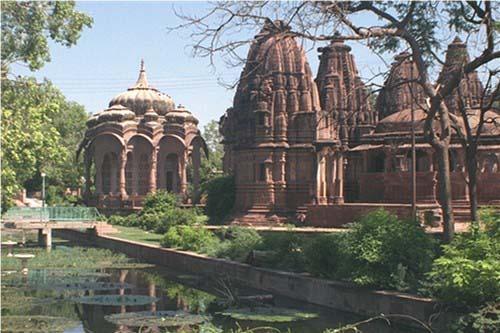
Teilhard went to India and read Vedanta, and
that he commented
on Ramanuja's interpretation, and remarked that his own ideas were similar.
For
more refer to chapter on Greater
India: Suvarnabhumi and Sacred
Angkor
***
A
religious concept of "evolution," which was consciously rejected by
Christian thought, has been basic to Hindu thought for millenia; every Hindu
religious practice assumes it. Teilhard
is well on his way towards the impersonal God when he writes: "Christ is
becoming more and more indispensable to me... but at the same time the figure of
the historical Christ is becoming less and less substantial and distinct to
me." "Christianity is still to some extent a refuge, but it does not
embrace, or satisfy or even lead the 'modern soul' any longer."
For
Teilhard de Chardin it is the Omega Point, which belongs to something that is
beyond representation. For Vivekananda it is the Om, the sacred syllable of the
Hindus: "All humanity, converging at the foot of that sacred place where is
set the symbol that is no symbol, the name that is beyond all sound."
(source:
The
Goal of Hinduism: The Universal Religion
- orthodoxphotos.com).
Kaikhushru Dhunjibhoy
Sethna in his book The Spirituality of the
Future, is critical not only of Zaehner but of many Catholic
expositions of the thought of Teilhard. These Catholic studies attempt to save
Teilhard for the church by pointing to his continuity with tradition, especially
with the Greek fathers, as if Teilhard's pantheism is Christian. As Teilhard has
come to be more and more acceptable within Catholicism, Sethna, from outside
Catholicism, seriously challenges his orthodoxy. Sethna argues that the
pantheism of Teilhard is truly a pantheism unacceptable within Roman
Catholicism. In fact, one of the major limitations in the thought of Teilhard
flows from the unfreedom within his church (keep in mind the post-Vatican I,
pre-Vatican II period within which he lived) which prevented him from going
fully where his spirit was leading him. Teilhard's Catholicism stands in the way
of Teilhard's spirituality, which is pantheistic in a sense fully in accord with
Indian Vedanta.
The 20th Century,
Teilhard de Chardin - most of his followers today would refuse to acknowledge
the influence of India on the development of his thoughts. Yes, and he actually,
during his exile in China for a few years, went to India. He bought a two-volume
book on Vedanta, which covered the four different schools of Vedanta. He wrote
notes on it. He commented on the Vedanta. He liked the particular interpretation
Ramanuja, who was in the 10th century and has been a major figure in Hinduism. He
wrote all that and yet in the mainstream conferences and books about Teilhard de
Chardin, you will be hard pressed to find people who will acknowledge that he
had any Indian influence upon him whatsoever.
(source:
Recent
Studies of Pierre Teilhard de Chardin - By Donald
Goergen - Spirituality Today - Fall
1982 Vol. 34).
 350.
Queen
Fredricka of Greece (1931- 1981)
The wife of King Paul of Greece. 350.
Queen
Fredricka of Greece (1931- 1981)
The wife of King Paul of Greece.
Queen Frederika had come to pay
homage to her guru, one of the Shankaracharyas,
following his book on non-dualism -i.e., absolute monism, also called
Advaita (or Advaita Vendanta). This
book was an exposition of the teachings of the ancient Hindu scriptures called
the Upanishads, or Vedanta.
While the Paramacharya was in
Kalahasthi, Queen Frederica of Greece, who had visited India at that time, came
to kalahasthi to have the blessings of the Paramacharya on December 3rd.
Queen
Frederika said that it was her advanced research in physics that had started her
on a spiritual quest.
It culminated in her accepting the non-dualism or absolute monism of
Shankara as her philosophy of life and science.
Long before physics discovered it, Shankara had
argued that the world of sense experience, that is the world of matter, was a
world of appearance (maya), because at the root of each individual existence is
the same energy which forms the cosmos. The
human self (atman) is ultimately not distinct from the universal self (brahma).
Duality is illusion. Reality
is not dual, but one. Science, said
Frederika, has yet to catch up with what the seers in India had already
understood over 2500 years ago. Therefore,
she said to the Rajmata,
‘You are fortunate to inherit such knowledge.
I envy you. While Greece is the
country of my birth, India is the country of my soul.’
(source:
A
Newsletter of the Kanchi Kamakoti Center of California
and From
the new physics to Hinduism).
 351.
Rajiv Malhotra ( ? ) After studying in Delhi's St. Columba's High School and
then St. Stephen's College, Rajiv arrived in the US in 1971 to study Physics and
Computer Science. His corporate careers and business entrepreneurship included
the computer, software and telecom industries. He now spends full time with The
Infinity
Foundation, a non-profit organization in Princeton, New Jersey. He
is also the author of new book -
Breaking India:
Western Interventions in Dravidian
and Dalit Faultlines 351.
Rajiv Malhotra ( ? ) After studying in Delhi's St. Columba's High School and
then St. Stephen's College, Rajiv arrived in the US in 1971 to study Physics and
Computer Science. His corporate careers and business entrepreneurship included
the computer, software and telecom industries. He now spends full time with The
Infinity
Foundation, a non-profit organization in Princeton, New Jersey. He
is also the author of new book -
Breaking India:
Western Interventions in Dravidian
and Dalit Faultlines
He has written
thus:
"In Hinduism, there is no central authority
to control people's personal beliefs in Hinduism, which respects many paths.
There are many God-Truths, but these are merely representations by different
people of a single God-Truth. This has given rise to hundreds of sects and sub
sects within Hinduism, which have learned to coexist."
"In Hinduism, there is no
concept similar to Christian martyrdom or Islamic jihad. The most important and
revered historical figures of Hinduism were not martyrs. Spirituality is not
about fighting someone or some religion. There is no discussion of other
religions in Hindu scriptures, no campaigns against "false gods."
Comparative religion is not of much interest to Hindus, as they do not see
religion through competitive or predatory eyes. Comparative
religion is not of much interest to Hindus, as they do not see religion through
competitive or predatory eyes. Christians, on the other hand, go out of their
way to control positions in academics, to research and to teach about Hinduism,
as a sort of competitor intelligence gathering which seeks hegemony. "
"Hindus
fail to understand the critical
history-dependence of the Abrahamic religions
and
the way their core myths and institutions are built around these frozen smritis.
Often what Hindus really mean is that all religions are equal in the respect and
rights they deserve, but they confuse this with sameness. Hindu
scholars to develop a rigorous approach to purva-paksha (scholarly critiques of
other traditions within the framework of the Indian darshanas); to highlight the
Hindu history of constructions through its own smriti traditions; and to refute
false presuppositions about Hinduism that have spread into many academic
disciplines."
(source: An
Unholy Business - hinduismtoday.com
and Myth
of Hindu Sameness
-
By Rajiv Malhotra.
For more on Rajiv Malhotra refer to chapters on Glimpses
IX and Glimpses
X and Glimpses
XI and The
Axis of Neocolonialism and Where
is India in the Clash of Civlization – By Rajiv Malhotra
and
Dharma's Good News: You Are Not a Sinner! - huffingtonpost.com
 352. Stephen H Ruppenthal
( ? ) Son
of a TWA pilot, he could travel across the world but India hooked him during his
first visit. Later he would come to know the spiritual master Eknath
Easwaran and work with him for about three decades. The
author of the recently published The
Path of Direct Awakening: Passages for Meditation
was barely 14 when he fell in love with India. 352. Stephen H Ruppenthal
( ? ) Son
of a TWA pilot, he could travel across the world but India hooked him during his
first visit. Later he would come to know the spiritual master Eknath
Easwaran and work with him for about three decades. The
author of the recently published The
Path of Direct Awakening: Passages for Meditation
was barely 14 when he fell in love with India.
" I have a special,
soft corner in my heart for Hinduism. It is like a mother to me, and I have
always felt so,"
A
journalist said not too long ago that my insights into India may have been due
to karma. Over the past month, I have thought a lot about that. Maybe I did have
some of India in me even before I landed there at age 14. Mine is the India of
the spirit. Before that, I was not religious in the least. But
I came away from India wanting passionately to find the deepest truth in
religion; not hear it from a church pulpit, but experience it in my
consciousness.
Any great treasure takes some work to find and
gain. When something is easily accessible, often it isn't worth that much, or
perhaps the hard work comes later down the road. To me, Indian
spirituality is a treasure of the highest order.
India stands for hope in a world full of violence
and despair. The fertile spiritual soil of India will bring forth a spiritual
figure who will guide the world back into love, into peace, into mutual respect
and caring for each other. That is how we will save this planet.
I am
more a devotee than a jnani. Though I
love the wisdom of the Upanishads
and such high philosophy and logic as the Nyaya-Vaishesheka
and Nagarjuna, I feel most drawn
to the life and example of Sri Krishna. Right now, religion is still
concepts up in my head. I want to have religion flooding my heart.
Sri Krishna
offers this in the Bhagvad Gita. That is why I have memorised all of chapters 2
through 12, plus 15 and parts of 18, for use in my passage meditation. When I
meditate on these passages, I try to repeat these words in my heart, where I
believe Sri Krishna resides in all his glory. In this regard, I have also
memorized all passages with the yin-yang symbol in my book that brings the same
peace and energy directly from nature and the magical world around us.
" I am captivated also by epics like the
Mahabharata and the Ramayana,"
(source:
Mine
is the India of the Spirit - interview with Stephen H Ruppenthal - rediff.com).
353. Professor
Robert P Goldman ( ? ) Professor
of Sanskrit at Berkeley. His areas of scholarly interest include Sanskrit
literature and literary theory, Indian Epic Studies. He is perhaps best
known for his work as the Director, General Editor, and a principal translator
of a massive and fully annotated translation of the critical edition of the
Valmiki Ramayana.
Goldman
said he fell in love with Indian culture and history when he was a 20-year-old
student at Columbia University, New York. "I was studying chemistry and
took up a course on Indian history," he said. "I became fascinated.
Indian history and culture was so rich," said Goldman, now 60. He took to
studying Sanskrit, which he found "very tough and complicated". But he
mastered it.
Delivering a lecture on ‘Ramayana:
Medieval Indian Interpretations’, organised by the University of Hyderabad as
part of its distinguished lecture series, Goldman
rejected the Western view that Ramayana was a mixture of the real and the
mythological.
“There’s
clear-cut evidence to show that the incidents described in Ramayana took
place,” he said here on Friday. Goldman said the experts had calculated the
exact period in which the war between Lord Rama and Ravana took place and the
time taken by Lord Hanuman to bring the Sanjeevani herb and how long the demon
Kumbhakarna used to sleep.
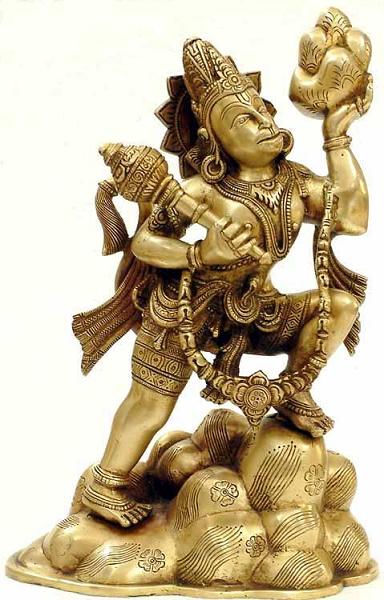
There’s
clear-cut evidence to show that the incidents described in Ramayana took place.
For
more refer to chapter on Greater
India: Suvarnabhumi and Sacred
Angkor
***
Goldman
said he believed that Hanuman flew to Sri Lanka and spoke a human language.
“It is something supernatural and something natural,” he said. “It is not
myth as is generally claimed by some Westerners. Rama-yana is a reality.”
"Valmiki's
Ramayan is the central document of Indian culture. The book and its message
express in an aesthetically pleasing and emotionally moving form what must be
seen as the most powerfully hegemonic discourse of the brahmanical and kshatriya
elites of India's epic age. It continues to be the basic and the founding
statement of social and political order in India even today. Greek epics like
Homer's Iliad is the book of a lost civilisation for today's Westerners. The
Ramayan is unique in continuing unbroken over almost 3000 years as the living
document of Indian civilisation. The Doordarshan serial's massive popularity
only served to remind people how important it continues to be
in shaping basic perceptions and social attitudes in India today."
"Ram's central act is not the destruction of
the demon king Ravan, but his cheerful acceptance of his wrongful disinheritance
and cruel exile to preserve the honour of his foolish father." "It is no exaggeration to say that in India everyone knows the Ram story.
In one sense, one has to know it to be part of Indian culture."
(source: Ramayana
was real: American professor - deccanchronicle.com and
saag.com
and How
fast do monkeys fly - in Ramayana?).
 354.
John
Burdon Sanderson Haldane (1892- 1964) the
world-renowned geneticist. In
1922, he joined Cambridge University to take up research in biochemistry
and in 1925, J.B.S. became interested in genetics-the study of genetics and
variations and this subsequently led him to his being elected Fellow of the
Royal Society in 1932. A year later he joined the University College, London, as
Professor of Genetics, a position he held as long as he stayed in Britain.
Haldane was the first to use mathematics in genetics. Among his significant
contributions is an estimate of the rate of mutation of a human gene. He wrote
articles on popular science and gave lectures. Some of his famous books are The
Causes of Evolution, New Paths in
Genetics and Biochemistry of Genetics. 354.
John
Burdon Sanderson Haldane (1892- 1964) the
world-renowned geneticist. In
1922, he joined Cambridge University to take up research in biochemistry
and in 1925, J.B.S. became interested in genetics-the study of genetics and
variations and this subsequently led him to his being elected Fellow of the
Royal Society in 1932. A year later he joined the University College, London, as
Professor of Genetics, a position he held as long as he stayed in Britain.
Haldane was the first to use mathematics in genetics. Among his significant
contributions is an estimate of the rate of mutation of a human gene. He wrote
articles on popular science and gave lectures. Some of his famous books are The
Causes of Evolution, New Paths in
Genetics and Biochemistry of Genetics.
Haldane was friends with the author Aldous
Huxley and was the basis for the biologist Shearwater in Huxley's novel
Antic Hay. Ideas from Haldane's Daedalus, such as ectogenesis (the
development of fetuses in artificial wombs), also influenced Huxley's Brave New
World. He had many students, the most famous of whom, John
Maynard Smith was perhaps also the one most like himself.
He left Britain in 1907
and come to live in India, a country he came to love during his several visits
here. He was inspired by Hindu philosophy, the Hindu way of life and the
principle of non-violence. The Gita impressed him. He even liked the dhoti and
kurta attire and used to wear them.
Disillusioned with Marxism in the 1940s and 50s, he
eventually moved to India to conduct scientific research.
He came to India with a purpose. He
became an Indian
citizen, and went native. He knew the country had a variety of animals
and plants in large numbers. He wanted to develop research in biology. He was at
first appointed professor at the India Statistical Institute, Calcutta and later
he became Director, Genetics and Biometry Laboratory in
Bhubaneswar, Orissa
where he died in 1964.
(source: British
geneticist who adopted Hinduism - vidyapatha.com).
 355.
Nirad C. Chaudhuri
(1897-1999) His first book, The Autobiography of an Unknown
Indian, was
published in 1951 and was followed by many others, including The Continent of
Circe, for which he won the Duff Cooper Memorial Prize, and Thy Hand Great
Anarch!, a second volume of memoirs. Booker Prize winner. Chaudhuri moved to
England in 1970. Sir
Naipaul has referred to him a foolish man who wrote one good
book, then went into kind of absurd fantasy, he built a whole book around
somebody who came with the invaders. His views on British rule were not popular in India. Once an
admirer of the British, he now finds them a decadent lot and their country in
steep decline. This is the final disillusionment for the man who dedicated The
Autobiography of an Unknown Indian to the British Empire! 355.
Nirad C. Chaudhuri
(1897-1999) His first book, The Autobiography of an Unknown
Indian, was
published in 1951 and was followed by many others, including The Continent of
Circe, for which he won the Duff Cooper Memorial Prize, and Thy Hand Great
Anarch!, a second volume of memoirs. Booker Prize winner. Chaudhuri moved to
England in 1970. Sir
Naipaul has referred to him a foolish man who wrote one good
book, then went into kind of absurd fantasy, he built a whole book around
somebody who came with the invaders. His views on British rule were not popular in India. Once an
admirer of the British, he now finds them a decadent lot and their country in
steep decline. This is the final disillusionment for the man who dedicated The
Autobiography of an Unknown Indian to the British Empire!
He writes about the vitality of Hinduism and the
lack of organization.
"The faith which the Hindus
had in their religion never wavered even in its worst days. It has had waxings
and wanings which has kept the balance even." " In judging the vitality
of Hinduism the point should be emphasized that it has maintained itself through
the ages and enforced obedience to itself without support from any kind of
organization, secular or spiritual."
(source: Hinduism:
a religion to live by - Nirad
C. Chaudhari
p.
116-120).
356.
Richard Garbe (1857–1927)
a professor at the University of Tübingen, had earned his reputation through
his scholarship on Indian philosophy, particularly his work on reconstructing
the Bhagavad Gita in its original form.
 His year-long trip to India in 1885 was
financed by the Prussian government through its Ministry of Culture and the
Royal Academy of Sciences in Berlin. Garbe kept a detailed record of his
experiences in India, which he published in 1889 under the title Indian
Travel Sketches. Garbe's travels and reactions to the East are
especially interesting because he was one of a handful of nineteenth-century
German Indologists (scholars of Indian culture and antiquity) who actually
visited India. His year-long trip to India in 1885 was
financed by the Prussian government through its Ministry of Culture and the
Royal Academy of Sciences in Berlin. Garbe kept a detailed record of his
experiences in India, which he published in 1889 under the title Indian
Travel Sketches. Garbe's travels and reactions to the East are
especially interesting because he was one of a handful of nineteenth-century
German Indologists (scholars of Indian culture and antiquity) who actually
visited India.
He had devoted a large part of his life to the
study of the Sankhya, consoled himself with the thought that 'in Kapila's
doctrine, for the first time in the history of the world, the complete
independence and freedom of the human mind, its full confidence in its own
powers, were exhibited."
(source: Philosophy of
Hinduism - By Galav p. 35).
357. Sir. Henry M.
Elliot ( ? ) author of History
of India, volume III has written:
"It it is asserted that Paradise is in
India,
Be not surprised, because Paradise itself is not comparable to it."
(source: History
of India - By Sir. H. M. Elliot vol. II p. 28-29).
358.
Girilal Jain (
- 1933) doyen of Indian journalists and editor of The Times of India from
1978-1988, was a passionate crusader of the Hindu cause. Author of
The Hindu
Phenomenon, he has observed:
"Many Hindu intellectuals are just not able
to comprehend the fact that there is no human
aspiration or experience which lies outside the range of Hinduism; it provides
for even demon-Gods. In contrast, all religions are in the
nature of sects, though they cannot be so defined because of their insistence on
their separateness and, indeed, hostility to Hinduism."
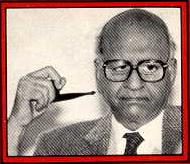 Hindus fought and lost, they
did not throw up prophets of woe and doom; they did not bemoan that
their Gods had let them down because they had been disloyal to them. Hindus are
perhaps unique in this respect. Hindus fought and lost, they
did not throw up prophets of woe and doom; they did not bemoan that
their Gods had let them down because they had been disloyal to them. Hindus are
perhaps unique in this respect.
"Hindus accept no divisions between the
believer and unbeliever. Every path leads to Him (God or Reality); there can be
as many paths to Him as the number of human. Indeed, the prophetic tradition is
alien to Hinduism. Narrowness of the spirit, peculiar to Semitic faiths, has
been alien to India."
The concept of nation itself is,
in fact, alien to the Hindu temperament and genius. Such a concept is
essentially Semitic in character even if it arose in western Europe in the
eighteenth century. The nation concept too emphasizes the exclusion of those who
do not belong to the charmed circle (territorial or linguistic or ethnic) as
much as it emphasizes the inclusion of those who fall within the circle.
By contrast, the essential spirit of Hinduism is 'inclusivist' and not 'exclusivisit'
by definition. In that
sense the Hindu fight is anxious to renew themselves in the spirit of their
civilization and the state and the political and intellectual class trapped in
the debris in which the British managed to bury our people before they
left."
(source: The
Hindu
Phenomenon - By Girilal
Jain p 5 -135 - South Asia Books
- 1998 ISBN
8174760105).
"The Semitic spirit is intolerant and insistent on the
pursuit of a particular course, whereas the Indian spirits is a broadminded and
tolerant one. To say therefore that Ram and Rahim are the same is, in my
opinion, a form of escapism or make-believe.
There is no concept, for example, in
Hinduism of kafir. You cannot be a kafir in Hinduism. You do not
cease to be a Hindu whatever you do, unless you choose to get converted to
another religion. You can be a Buddhist and a Hindu at the same time, not only
in a social sense but also in religious terms."
(source: Girilal
Jain on Hindu Rashtra - bharatvani.org).
359.
Swami
Akhilananda ( ? ) Texas raised Hindu disciple.
 The
first question most people ask the tall, blond, blue-eyed Hindu swami from
Texas, almost everywhere he goes on his traveling lectures, is how did he get to
be a Hindu swami. The
first question most people ask the tall, blond, blue-eyed Hindu swami from
Texas, almost everywhere he goes on his traveling lectures, is how did he get to
be a Hindu swami.
"People
always ask me that," said Swami Akhilananda, wearing sandals, beads, a
saffron robe and a vertical red streak on his forehead called a tilak during a
recent visit to the Hindu Temple and Cultural Center of Birmingham.
"Since
I was a young child I was raised as a Hindu," he said. "Hinduism
is such that, whatever you can ask, there's always an answer."
His
father, a carpenter, was a spiritual seeker who studied Hinduism and helped
oversee construction on the Barsana Dham, a Hindu Temple in Austin, Texas. Built
on 200 acres near a flowing stream, it's one of the largest Hindu temples in the
United States.
Steeped
in the history and scriptures of Hinduism, but raised in Texas, Swami
Akhilananda has emerged as an eloquent spokesman for the appeal of the ancient
religion to people who are not of Indian descent.
"Every
Hindu knows there's only one god and he manifests himself in many different
ways," Swami Akhilananda said.
The representations of gods are to help people
understand a formless reality, he said. "There are a lot of different
understandings of Hinduism," he said. "We don't do idol worship. It's
a way to visualize God."(source:
Texas-raised
Hindu disciple eloquently speaks of ancient religion’s appeal - Greg Garrison
- The
Salt Lake Tribune).
 360.
Dr. Frank Gaetano Morales
aka
Sri Dharma Pravartaka Acharya ( ? )
He earned a Ph.D in Languages and Cultures of Asia from the University of
Wisconsin, Madison. He specializes in Sanskrit, Hindu Studies, Philosophy of
Religion and History of Religion. At the young age of 14, Dr. Morales visited a
Hindu temple for the first time. So awed was he with the majestic beauty and
spiritual power that he encountered in this temple that, on the spot, he decided
to devote his life to the path of Yoga. After living the life of a celibate Yoga
monk for six years, Dr. Morales was ordained as a brahmana (a spiritual
teacher) in 1986. His Sanskrit name is Sri Dharma Pravartaka Acharya. He is a
follower of the ancient Vishishta-Advaita
philosophy of Ramanuja. His first book
Experiencing Truth: The
Vedic Way of Knowing God is scheduled to be published by Motilal
Banarsidass Publishers. 360.
Dr. Frank Gaetano Morales
aka
Sri Dharma Pravartaka Acharya ( ? )
He earned a Ph.D in Languages and Cultures of Asia from the University of
Wisconsin, Madison. He specializes in Sanskrit, Hindu Studies, Philosophy of
Religion and History of Religion. At the young age of 14, Dr. Morales visited a
Hindu temple for the first time. So awed was he with the majestic beauty and
spiritual power that he encountered in this temple that, on the spot, he decided
to devote his life to the path of Yoga. After living the life of a celibate Yoga
monk for six years, Dr. Morales was ordained as a brahmana (a spiritual
teacher) in 1986. His Sanskrit name is Sri Dharma Pravartaka Acharya. He is a
follower of the ancient Vishishta-Advaita
philosophy of Ramanuja. His first book
Experiencing Truth: The
Vedic Way of Knowing God is scheduled to be published by Motilal
Banarsidass Publishers.
He has observed:
"The Sanskrit word
"Sanatana" denotes that which always is, that which has neither
beginning nor end, that which is eternal. Sanatana Dharma can cautiously be
translated as The Eternal Natural Way". Hinduism
is a way of life and world-view that is trans-geographical: traces of
Sanatana Dharma are to be found in many of the ancient cultures of the world. No
one actually knows when Sanatana Dharma was first started. Both practitioners of
Hinduism, as well as all academic scholars of Hinduism, agree that there was no
one specific time in known history when the religion was founded. Additionally,
there was no one individual - a prophet, saint or priest - who can be claimed as
the founder of the religion. It is an eternal spiritual culture that is as old
as the Earth herself. Moreover, it is the sustainer of the Earth. This is
indicated by the meanings of the two words that constitute the very name of this
culture: sanatana means “eternal” and dharma means “natural
law."
(source: Dharma Central -
http://www.dharmacentral.com/faq.htm).

Lord Ganesha: God of Wisdom
Hinduism is an eternal spiritual culture that is as old
as the Earth herself. Moreover, it is the sustainer of the Earth.
This is
indicated by the meanings of the two words that constitute the very name of this
culture: Sanatana means “eternal” and Dharma means “natural
law."
For
more refer to chapter on Greater
India: Suvarnabhumi and Sacred
Angkor
***
"The related terms "myth",
"mythology", "mythological", etc., have had an interesting
history and a very pointed polemic use. That the terms are rife with very
negative connotations is doubted by very few. The way the terms are used today
both within academia, as well as by the general public, is to denote something
which is untrue, false, "primitive" (i.e., not European), a lie.
Polemically speaking, one culture's "myth" is another culture's sacred
history...and visa versa. The academic field of the study of
"mythological" literature was started by 18th century European
Classicists who took their misconceptions about their own Greco-Roman
pre-Christian religious and cultural heritage and attempted to apply them to all
contemporary non-Christian cultures - including that of Bharat. There is the
wonderful saying that we have all heard, that "history" is written by
the victors. Consequently, the stories of Noah's Ark, Abraham, Moses, the
Judges, David, etc. are unquestioningly accepted by most European historians -
and sadly by many Hindu historians! - as being incontrovertible and established
fact. What these Western scholars and their Westernized Indian counterparts
called the "mythical" Sarasvati River, for example, was discovered to
be a concrete geological fact in our century by satellite photography; Krishna's
"mythical" city of Dvaraka was, likewise, discovered off the coast of
Gujarat about two decades ago. Despite these facts, the Puranas, Itihasas and
traditional histories of Bharat, unlike the Biblical "myths", are
relegated by modern Western scholars to the misty realm of "myth".
Bluntly: primitive fables. If you've guessed that what has brought this
situation about has been nothing less than European racism and intellectual
colonialism, coupled with a strong element of Hindu inferiority complex, you've
guessed right! The terms "myth", "mythology",
"mythological", etc., have been used as a powerful weapon by
anti-Hindu bigots for decades as a way of delegitimizing Hindu beliefs and the
Hindu way of life. Such terms should be absolutely anathema to every sincere and
self-respecting Hindu when speaking about the sacred stories of Sanatana Dharma.
Our stories are not "myths". If we truly respect our religion, our
culture, our selves, we must never use these terms again. Rather, we should do
what many other formally oppressed non-Christian cultures have recently done
(such as many Native American tribes), and call these "Sacred
Stories".
(source: Word as Weapon - By Frank Morales - Hindu
Renaissance magazine).
Also refer to Does
Hinduism Teach That All Religions Are The Same? A Philosophical Critique of
Radical Universalism - By
Dr. Frank Gaetano Morales.
Refer
to A
Map of Sacred Stories of the Ancient World
- Contributed to this site
by Dom Sturiale of Sydney, Australia.
Refer to The
World of Myth - By Ramesh N Rao - sulekha.com).
Top of Page
Quotes361_380
 

Page < 1 2 3 4 5 6 7 8 9 10 11 12 13 14 15 16 17 18 19 20 21 22 23 24 >
|